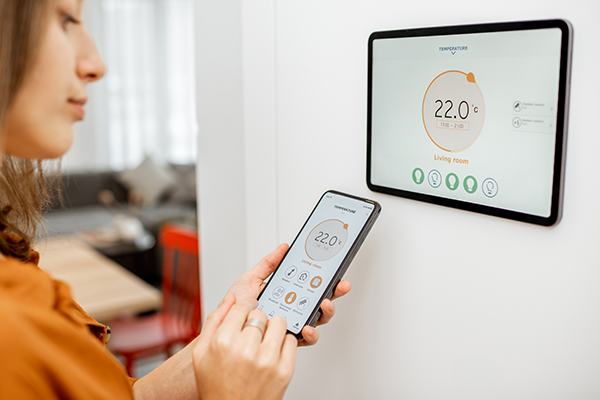HVAC Technology in 2020: Smart Homes, 24-Hour Monitoring, and VR
Technology: some love to be on the cutting edge, and some just can’t seem to keep up. Methods of heating and cooling have come a long way from wood-burning furnaces or coal to energy-efficient efficient units run by renewable energy sources. The systems that run our units have gotten smarter as well! Here are some advances in heating and cooling technology that are taking us into the future.
Wifi-Enabled Programmable Thermostats & Smart Home Apps
“Just programmable thermostats” are making room for wifi-enabled programmable thermostats. These cutting-edge devices can learn your schedule, detect when you’re home/away, prioritize high-use rooms, and allow you to monitor and adjust your home’s setting remotely from anywhere – all while saving on heating and cooling costs, of course. Many systems come with integrations to Amazon Alexa and Google Nest, allowing for voice control of actions and settings and integration with other smart home products like smart speakers, doorbells, cameras, locks, and more. In fact, as many as 35% of large-scale home builders are now installing whole-home networks (infrastructure for smart-homes) as standard in their new homes. It won’t be long before the vast majority of homes upgrade to the convenience, energy-tracking ability, and energy efficiency of wifi-enabled thermostats and smart home products and apps.
Did you know? Columbia Heating & Cooling will include a FREE Nest Learning Thermostat with any all-new installation. Contact us for details!
Residential HVAC System Monitoring
Some HVAC thermostat systems now monitor the efficiency of your unit, let you know when it’s time to change a dirty filter, when you’re low on refrigerant, or if something is broken or blocked. System self-monitoring is leading the way for more comprehensive residential monitoring by HVAC companies themselves. 60% of HVAC systems are operating below capacity indicated by manufacturers. This isn’t good for manufactures or home owners unnecessarily losing out on significant levels of wasted energy and the needlessly high utility bills that follow. Some HVAC product manufacturers like Honeywell have introduced 24-hour remote monitoring of residential HVAC systems. Any connected Honeywell thermostat sends unit information directly to a homeowner’s designated HVAC contractor through a secure contractor portal. The portal allows the contractor to monitor the system, see if it’s running below peak performance, spot trouble early, fix some issues remotely, and even schedule proactive service calls when needed. Diagnostic information can point contractors to the problem faster and help them predict which tools and products to bring to in-home appointments in advance. For those who opt for it, systems with detailed monitoring like Honeywell’s’ can revolutionize both the homeowner experience and contractors’ potential level of service.
HVAC Virtual Reality Training
Technology is also leading the way to virtual reality training for HVAC technicians. These digital, cost-effective tools are beneficial for trade schools, new employees, and season techs learning about new technology or working on advanced certifications. Companies like Interplay Learning have released 3D simulation training available on desktop, tablet, phone, or VR-headset with over 100 hours of scenario-based exercises on a variety of equipment. These courses give trainees an interactive experience with HVAC units and systems and help them engage troubleshooting techniques to solve real-world problems for a genuinely field-like experience. Well trained techs provide better, more efficient, and more comprehensive service to homeowners like you!
The future is bright for the HVAC industry and we look forward to brand new innovations while continuing the age-old tradition of providing high-quality service to our valued customers. Schedule your service today!

